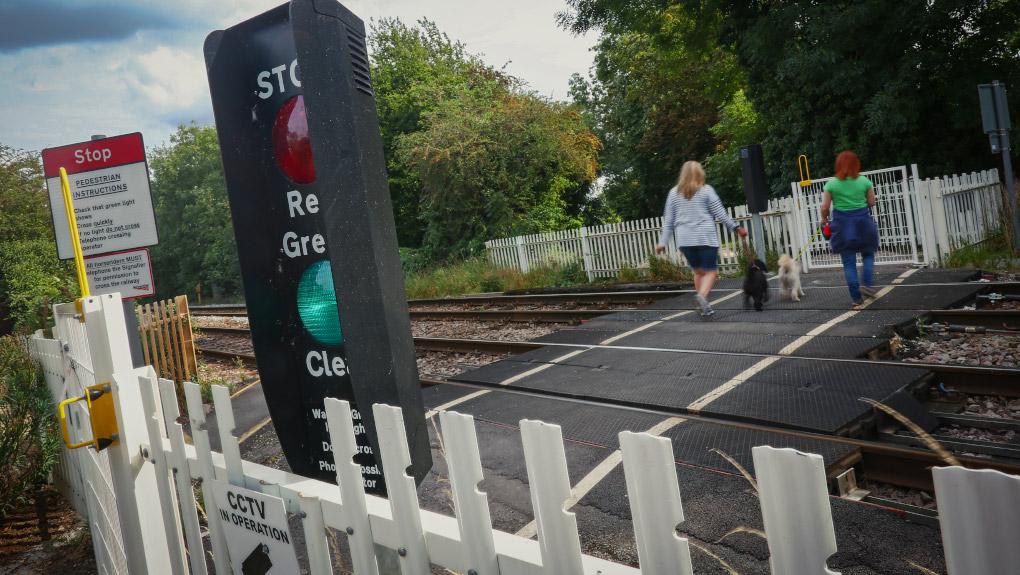
Principles for managing level crossing safety, emphasises that risk should be reduced through the design of a level crossing or through an alternative way of crossing the railway where this is reasonably practicable, and the importance of considering how level crossings are actually used.
There are currently just under 5,800 level crossings on the mainline railway with around another 1,500 on heritage railways, and safety at crossings has been improved in recent years.
ORR’s guidance supports a risk-based approach, which ensures cost is taken into account when considering safety measures, but it does not specify requirements or solutions allowing a proportionate, case-by-case approach to be made by duty holders.
To support the guidance, examples have been put together to show how the principles might be applied in practice.
One scenario highlights a footpath level crossing, where plans to increase the speed and frequency of trains on the line sees new warning lights with an audible alarm installed to help users cross.
Another example highlights how a heritage railway lowered risks to users by carrying out a risk assessment to identify alternative ways of crossing the railway, resulting in a new pedestrian bridge and staffing of the level crossing for use by disabled passengers.
ORR’s new guidance follows a consultation in January that found industry welcomed the focus on managing level crossing risk in a collaborative way, recognising level crossings are the interface between railway and highway.
ORR’s consultation also highlighted the need for the regulator to clarify its role in relation to level crossings and it has updated its website to provide better signposting to the roles of other parties who have responsibilities at level crossings.
Ian Prosser CBE, HM Chief Inspector of Railways, ORR said:
The new principles mark a step change from the previous guidance, Level Crossings: Guidance for Managers, Designers and Operators – also known as RSP7, which describes level crossing methods of operation and layouts. In time, RSP7 will be withdrawn from use.
In total, there are nine principles to help users of the guidance consider how to make crossings safe for the user by following their journey of using a crossing to help identify hazards at a level crossing. There are also nine principles to guide risk control measures for a level crossing from the perspective of the railway, and five to control risks from a highways perspective which includes preventing road traffic incidents at or near a level crossing.
Industry has welcomed the improved guidance to help manage risks and make clearer the roles across industry.
Rob Wainwright, Head of Level Crossings at Network Rail and chair of the industry level crossing strategy group, said:
Jay Heavisides, Principal Risk Analyst at the Rail Safety Standards Board (RSSB), said:
Notes to editors
- ORR has particular involvement in level crossing safety through the:
- Health and Safety at Work etc. Act 1974 - this puts a duty on employers to secure the health, safety and welfare of employees, as well as protecting the public against risks to health or safety arising out of work activities.
- Level Crossings Act 1983 - this authorises the Secretary of State for Transport to make level crossing orders for the protection of those using a level crossing. ORR usually does this on behalf of the Secretary of State. Level crossing orders cover individual level crossings. They specify the protective equipment required at a crossing.
- ORR’s guidance will replace the Level Crossings: Guidance for Managers, Designers and Operators or RSP7.
- ORR worked together with the heritage and mainline rail industries, local authorities and rail organisations to write the guidance. ORR’s website has also been updated.
- Level crossings provide access routes across our railways for the public and for private landowners, but they present a particular safety challenge which has increased as our railways and highways have become busier. They are a priority topic for the Office of Rail and Road (ORR) because of the potential for harm and injury to members of the public.
- Minor and heritage railways are 'lines of local interest', museum railways or tourist railways that preserve, re-create or simulate railways of the past; or demonstrate or operate historical or special types of motive power or rolling stock. There are well over 200 such railways operating across Great Britain and ORR is responsible for regulating their safety.

